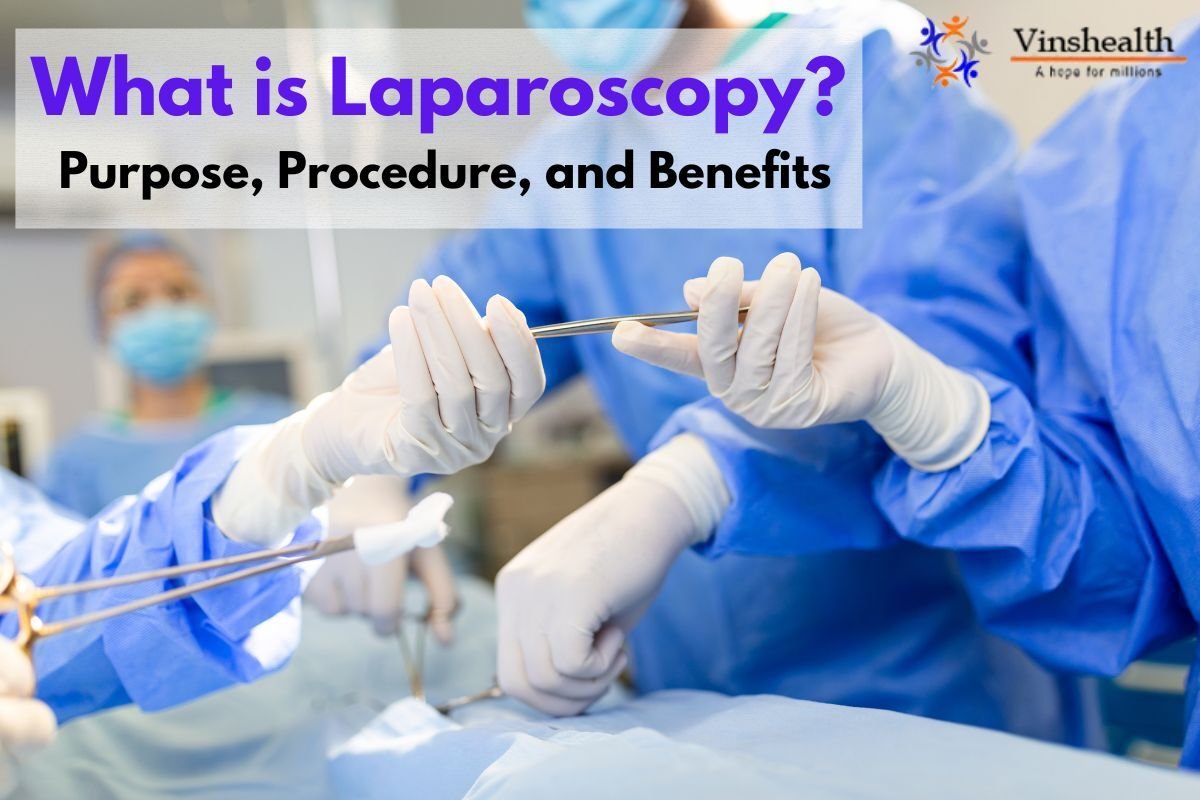What is Laparoscopy, Purpose, Procedure and Benefits
- 2023-09-26
- Laparoscopy, What is Laparoscopy
In the realm of modern medicine, laparoscopy stands as a revolutionary technique that has transformed the landscape of surgical procedures. Whether you're a patient curious about the meaning of laparoscopy or someone contemplating the need for this procedure, this comprehensive guide will delve deep into the world of laparoscopy. From its fundamental definition to the advanced forms of laparoscopic surgery, we'll cover it all. So, let's begin our journey to understand the meaning of laparoscopy and explore its significance in the realm of healthcare.
Table of Content
- What is Laparoscopy? The Meaning of Laparoscopy
- Why do I need a Laparoscopy?
- Types of Laparoscopy
- Laparoscopy Procedure
- Benefits of Laparoscopy
- Are there any risks to the test?
- Diagnostic Laparoscopy
- Laparoscopy Recovery Time
- Laparoscopy Before and After
- Advanced Kinds of Laparoscopic Surgery
- When should I contact my doctor after laparoscopy?
What is Laparoscopy? The Meaning of Laparoscopy
Laparoscopy, often referred to as minimally invasive surgery, is a medical procedure that allows surgeons to visualize, diagnose, and perform surgeries within the abdominal and pelvic regions. Unlike traditional open surgeries that involve large incisions, laparoscopy employs small incisions through which a specialized instrument called a laparoscope is inserted. This slender, lighted tube equipped with a camera provides real-time high-definition imagery of the internal organs, guiding the surgeon throughout the procedure.
The primary goal of laparoscopy is to minimize trauma to the body, reduce recovery time, and enhance precision in surgical interventions. In essence, laparoscopy enables surgeons to achieve the same outcomes as traditional surgery but with smaller incisions and reduced postoperative complications.
Why Do I Need a Laparoscopy?
- Diagnostic Purposes: Laparoscopy is commonly used for diagnostic purposes when a patient presents with vague or unexplained symptoms. It allows doctors to visualize the internal organs, identify abnormalities, and make an accurate diagnosis. Conditions like endometriosis, ovarian cysts, and certain cancers can be diagnosed through laparoscopy.
- Treatment and Surgery: Beyond diagnosis, laparoscopy is employed for various surgical interventions. It is a preferred method for conditions like gallstones, hernias, appendicitis, and obesity-related surgeries. Laparoscopic surgery offers quicker recovery times and reduced scarring compared to traditional open surgeries.
- Biopsy: In cases where tissue samples are required for examination, laparoscopy can be used to collect biopsy samples from different organs. This minimally invasive approach reduces patient discomfort and promotes faster healing.
Types of Laparoscopy
Laparoscopy is a versatile technique used across different medical specialties. Here are some common types:
- Diagnostic Laparoscopy: This is performed primarily for diagnosis. The surgeon examines the abdominal and pelvic organs for abnormalities, often without performing any surgical procedures during the same session.
- Operative Laparoscopy: In this type, laparoscopy is used not only for diagnosis but also for surgical intervention. The surgeon can remove cysts, tumors, or perform procedures like cholecystectomy (gallbladder removal) and appendectomy (appendix removal).
- Therapeutic Laparoscopy: This involves the treatment of certain conditions using laparoscopy. For instance, endometriosis can be treated by removing abnormal tissue through therapeutic laparoscopy.
- Advanced Kinds of Laparoscopic Surgery: These are specialized forms of laparoscopy designed for complex surgeries. Examples include robotic-assisted laparoscopy and single-incision laparoscopy, which offer even greater precision and reduced scarring.
Laparoscopy Procedure
The laparoscopy procedure typically follows these steps:
- Anesthesia: Before the surgery begins, the patient is administered either general anesthesia or local anesthesia with sedation to ensure comfort and pain control throughout the procedure.
- Incision: Small incisions (usually 0.5 to 1.5 cm) are made near the surgical site to allow the insertion of the laparoscope and surgical instruments.
- Gas Insufflation: Carbon dioxide gas is gently pumped into the abdominal cavity through one of the incisions. This inflates the abdomen, creating space for the surgeon to work and allowing better visibility.
- Laparoscope Insertion: The laparoscope, equipped with a camera, is inserted through one of the incisions. The real-time images captured by the camera are displayed on a monitor in the operating room, guiding the surgeon's actions.
- Surgical Procedure: Using specialized instruments inserted through the remaining incisions, the surgeon performs the necessary surgical procedure. This could involve removing damaged tissue, repairing organs, or collecting biopsy samples.
- Closure: Once the procedure is complete, the instruments are removed, and the small incisions are closed with sutures or adhesive strips. In some cases, no sutures are needed due to the minimal size of the incisions.
Benefits of Laparoscopy
Laparoscopy offers a multitude of advantages compared to traditional open surgeries:
- Minimal Scarring: The small incisions result in minimal scarring, which is not only cosmetically preferable but also reduces the risk of postoperative infections.
- Quicker Recovery: Patients often experience shorter hospital stays and faster recovery times, allowing them to return to their normal activities sooner.
- Reduced Pain: Since laparoscopy involves smaller incisions and less tissue damage, patients typically experience less postoperative pain.
- Lower Risk of Infection: Smaller incisions mean a lower risk of infection at the surgical site.
- Improved Precision: The laparoscope provides a magnified, high-definition view of the surgical area, enabling surgeons to perform complex procedures with greater accuracy.
Are There Any Risks to the Test?
While laparoscopy is generally considered safe, like any medical procedure, it carries some risks and potential complications. These may include:
- Infection: Although the risk is lower than with open surgery, there is still a slight chance of infection at the incision sites.
- Internal Bleeding: While rare, internal bleeding can occur during or after laparoscopy.
- Organ Damage: In very rare cases, surgical instruments can cause damage to nearby organs.
- Anesthesia Complications: Some patients may experience adverse reactions to anesthesia.
- Blood Clots: There is a small risk of developing blood clots in the legs, known as deep vein thrombosis (DVT).
It's essential to discuss these risks with your healthcare provider before undergoing laparoscopy, as they can provide personalized information based on your specific medical history and the nature of the procedure.
Diagnostic Laparoscopy
Diagnostic laparoscopy is a crucial tool in the arsenal of medical professionals. Here's how it plays a vital role in healthcare:
- Uncovering Hidden Conditions: Diagnostic laparoscopy allows doctors to investigate and identify conditions that may not be detectable through other means. This is particularly useful when a patient experiences unexplained symptoms.
- Precision Diagnosis: By directly visualizing the organs and tissues, diagnostic laparoscopy can provide a more precise diagnosis, enabling doctors to tailor treatment plans accordingly.
- Faster Diagnosis: Traditional diagnostic methods, such as exploratory open surgery, can be much more invasive and require longer hospital stays. Diagnostic laparoscopy is minimally invasive, leading to faster diagnosis and recovery.
- Guiding Treatment Decisions: Once a diagnosis is made, doctors can make informed decisions about treatment options. This ensures that patients receive the most appropriate care for their specific condition.
Laparoscopy Recovery Time
One of the key advantages of laparoscopy is the relatively short recovery time. The exact recovery period can vary depending on several factors, including the type of procedure performed and the individual patient's health.
- Immediate Postoperative Period: After the laparoscopy procedure, patients are typically observed in a recovery room until they awaken from anesthesia. The majority of patients are able to return home the day of or the day after surgery.
- Return to Normal Activities: Patients can usually resume light activities within a few days to a week after the surgery. However, strenuous activities and heavy lifting should be avoided for several weeks, as recommended by the surgeon.
- Pain and Discomfort: While laparoscopy is less painful than open surgery, some discomfort is normal. Pain medication may be prescribed to manage postoperative pain.
- Diet: Patients may need to follow a specific diet plan for a short period after surgery, especially if the procedure involves the gastrointestinal tract. Dietary advice will be given to you by your doctor.
- Follow-up Appointments: It's essential to attend follow-up appointments as scheduled to ensure proper healing and monitor for any complications.
Laparoscopy Before and After
Before undergoing laparoscopy, there are several essential considerations:
- Consultation: Schedule a consultation with your healthcare provider to discuss the need for laparoscopy, the specific procedure, and any potential risks or complications.
- Preoperative Preparation: Depending on the type of procedure, you may need to follow specific preoperative instructions, such as fasting before surgery and discontinuing certain medications.
- Support System: Arrange for someone to drive you home after the surgery and provide assistance during the initial recovery period.
- Postoperative Care: After laparoscopy, follow your surgeon's postoperative care instructions diligently. This includes following food restrictions, taking prescribed medications, and going to follow-up appointments.
- Monitoring for Complications: Be vigilant about any signs of infection, excessive bleeding, or other unusual symptoms and promptly inform your healthcare provider if you notice any issues.
Advanced Kinds of Laparoscopic Surgery
As medical technology continues to advance, laparoscopy has evolved into more specialized forms. Two noteworthy advancements are:
- Robotic-Assisted Laparoscopy: This technology incorporates robotic arms operated by the surgeon, providing enhanced dexterity and precision. Robotic-assisted laparoscopy is especially valuable for intricate surgeries such as prostatectomy and hysterectomy.
- Single-Incision Laparoscopy: In this innovative approach, all instruments and the laparoscope are inserted through a single incision, typically hidden within the navel. This technique minimizes scarring and offers a cosmetic advantage.
These advanced forms of laparoscopy are often utilized for complex surgeries and can further reduce recovery time and discomfort.
When Should I Contact My Doctor After Laparoscopy?
While laparoscopy is generally a safe and minimally invasive procedure, it's essential to stay vigilant about your health during the recovery period. Here are some situations in which you should contact your doctor promptly:
- Fever: If you develop a fever after laparoscopy, it could be a sign of infection. Contact your healthcare provider if your temperature exceeds 100.4°F (38°C).
- Severe Pain: While some discomfort is normal, severe or worsening pain should be reported to your surgeon immediately.
- Excessive Bleeding: If you experience heavy bleeding from the incision sites, notify your doctor immediately.
- Signs of Infection: Watch for signs of infection such as redness, swelling, warmth, or discharge at the incision sites.
- Breathing Problems: If you have difficulty breathing or experience chest pain, seek medical attention immediately, as this could indicate a serious complication.
- Persistent Nausea or Vomiting: Continuous nausea or vomiting could be a sign of an adverse reaction to anesthesia or another complication.
Laparoscopy, with its minimally invasive approach and versatile applications, has revolutionized the field of surgery and diagnostic medicine. Understanding the meaning of laparoscopy and its various types, benefits, and potential risks is crucial for patients considering this procedure. Whether you're seeking a diagnosis or contemplating surgery, laparoscopy offers a less invasive, more precise, and faster path to recovery. As technology continues to advance, the future holds even more promise for the world of laparoscopy, with innovations like robotic-assisted and single-incision techniques pushing the boundaries of what's possible in modern medicine. Always consult with your healthcare provider to determine the best course of action for your specific medical needs, and remember to follow postoperative care instructions diligently to ensure a smooth recovery.
Frequently Asked Questions (Laparoscopy)
Q: What is the primary purpose of laparoscopy?
A: Laparoscopy serves two main purposes: diagnosis and surgery. It allows doctors to visually inspect and diagnose conditions within the abdominal and pelvic regions. It is also used for minimally invasive surgeries to treat various medical conditions.
Q: How is laparoscopy different from traditional open surgery?
A: Laparoscopy involves small incisions and the use of a laparoscope (a camera-equipped tube) to visualize the internal organs, while traditional open surgery requires a large incision. Laparoscopy typically results in less scarring, reduced pain, and quicker recovery.
Q: What are the common medical conditions that can be diagnosed through laparoscopy?
A: Laparoscopy is used to diagnose a wide range of conditions, including endometriosis, ovarian cysts, gallstones, appendicitis, and certain cancers, among others. It is particularly valuable when symptoms are unclear or unexplained.
Q: What are the benefits of choosing laparoscopy over open surgery?
A: The benefits of laparoscopy include minimal scarring, quicker recovery, reduced pain, lower risk of infection, and improved precision during surgery. Patients often experience shorter hospital stays and can return to normal activities sooner.
Q: Are there any risks associated with laparoscopy?
A: While laparoscopy is generally safe, there are some risks, including infection, internal bleeding, organ damage (rare), anesthesia complications, and blood clots (rare). The specific risks may vary depending on the individual and the procedure.
Q: How long is the typical recovery time after a laparoscopy procedure?
A: The duration of recovery varies, influenced by both the specific procedure undertaken and the individual's overall health. Typically, patients can return to light activities within a few days to a week. However, it is advisable to refrain from engaging in strenuous activities and lifting heavy objects for a period of several weeks, as per the guidance provided by the surgeon.
Q: What should I do before and after a laparoscopy procedure to ensure a smooth recovery?
A: Before laparoscopy, schedule a consultation with your healthcare provider, follow any preoperative instructions, arrange for postoperative support, and be prepared to adhere to dietary and medication guidelines afterward. After the procedure, closely follow your surgeon's postoperative care instructions.
Best Laparoscopy Doctors list
Laparoscopy in Delhi
Laparoscopy in Nehru Enclave
Laparoscopy in Rajendra Palace
Laparoscopy in Dwarka
Laparoscopy in Patparganj
Laparoscopy in Vasant Kunj
Laparoscopy in Greater Kailash








Leave Comment